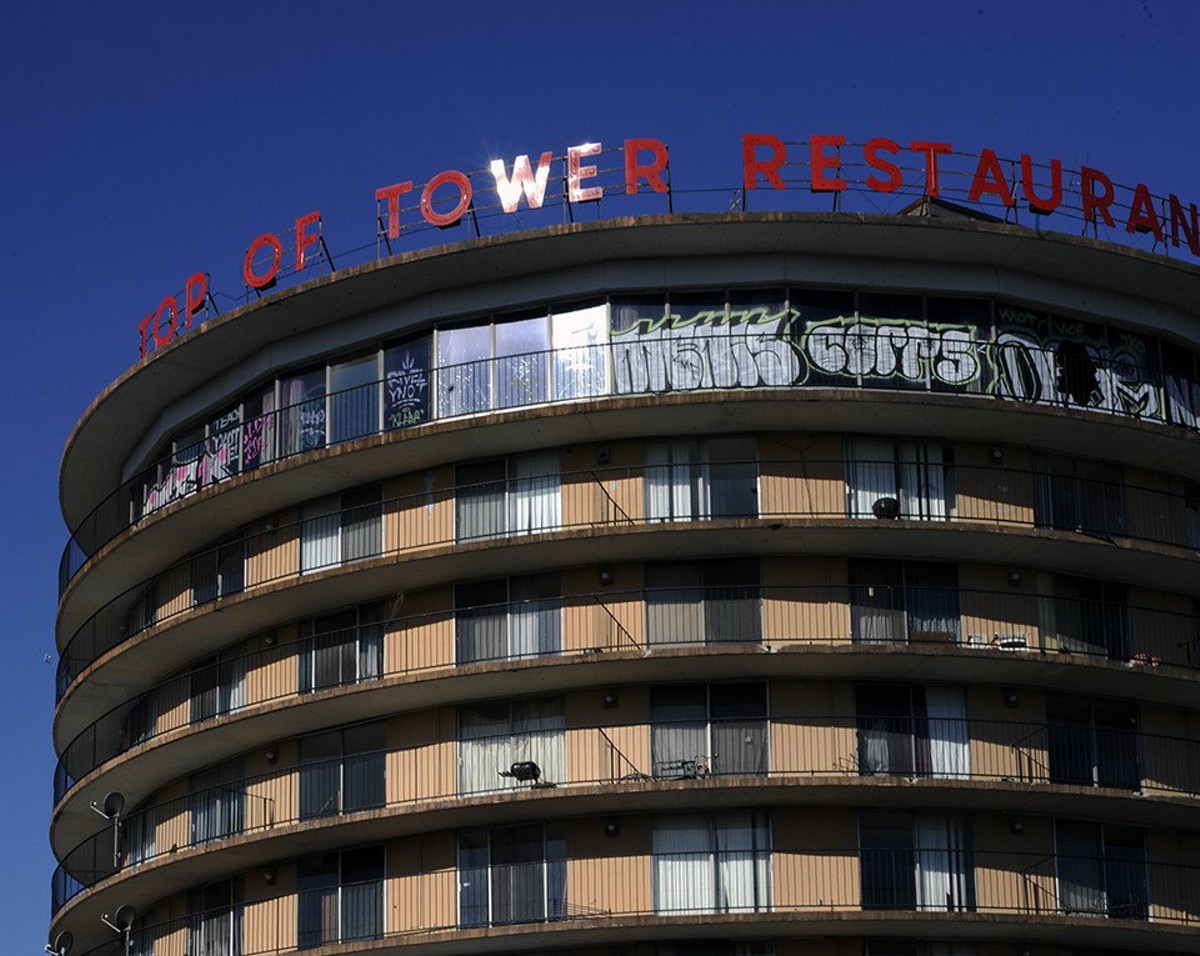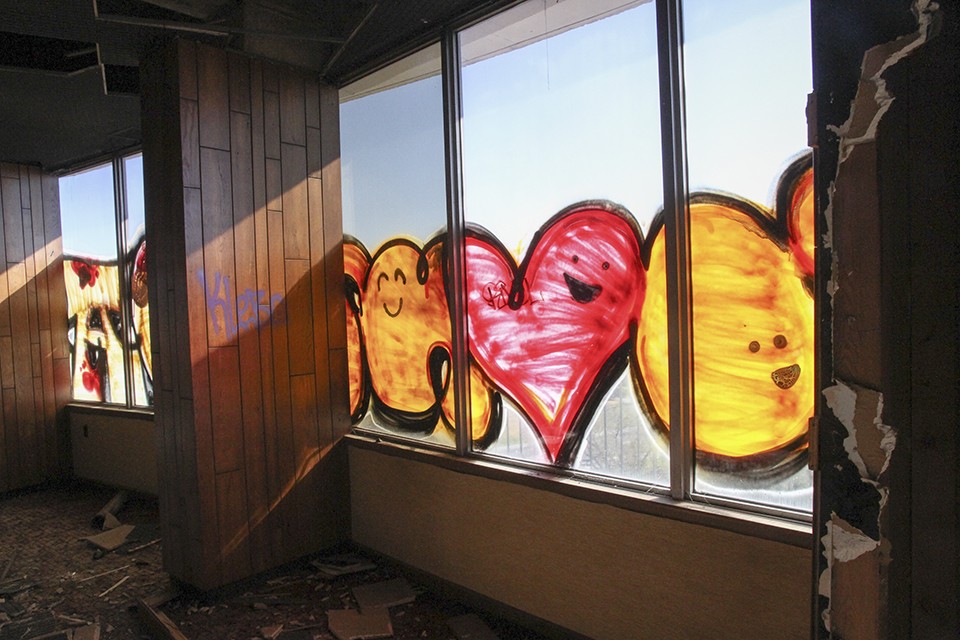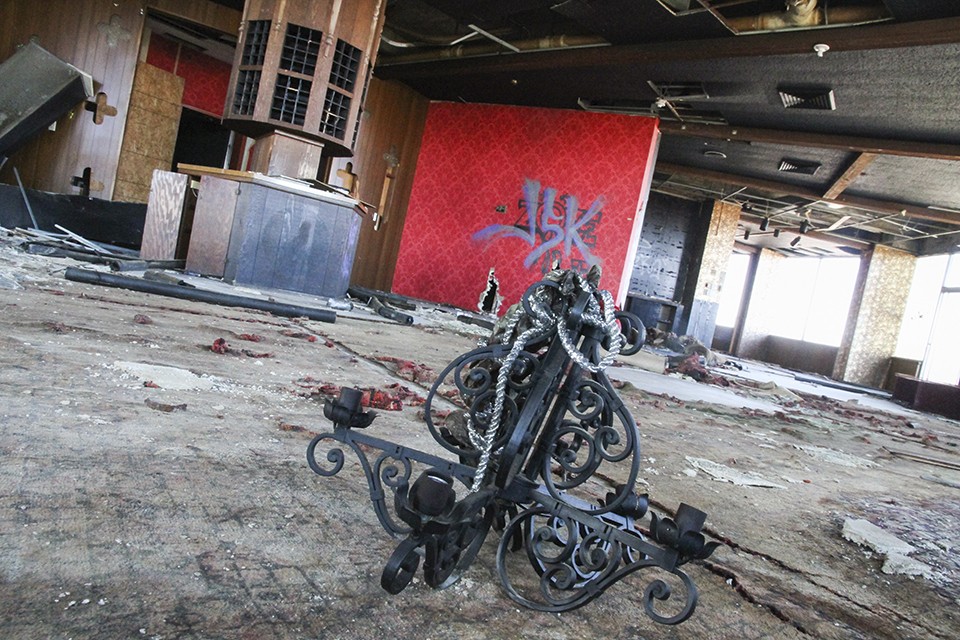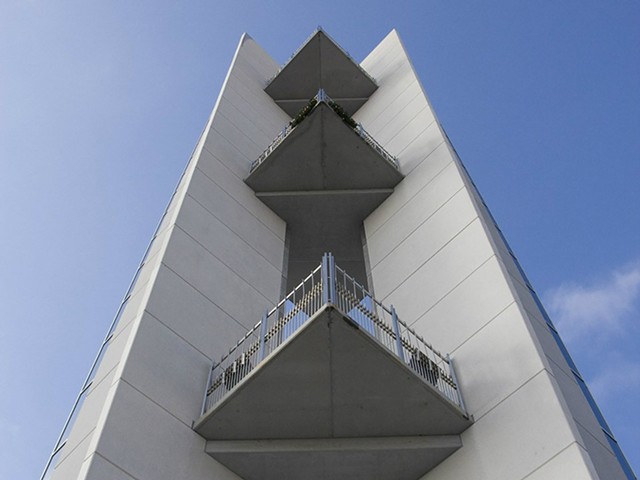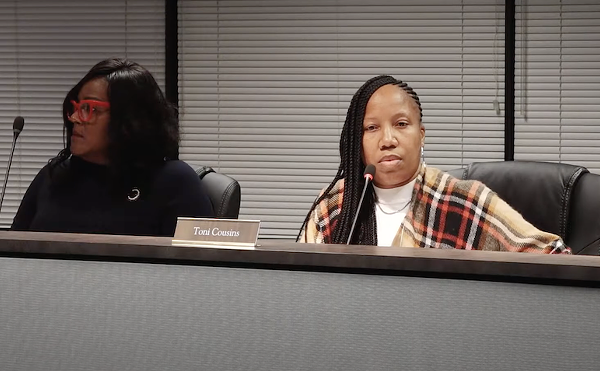While the front doors of the Lewis & Clark Tower are firmly sealed with an industrial-sized padlock-and-chain combo, entry to the building doesn't require a lot of work or innovation, as a large pane of glass just steps away has been smashed to bits. It's one of several entry points, and it's obvious from a self-guided tour that dozens of people have called this place "home" since the last official residents left in 2014 — this despite thousands of dollars in municipal funds for board-up efforts.
Just inside the doorway, a business directory in the curved lobby gives a decent sense of what was left when the building was emptied of both of residents and businesses. Paperwork, photos and other assorted detritus give a sense of lives lived in the nine lower floors (the restaurant took up all of the tenth).
See also: 15 Haunting Photos from Inside the Tower
The first, second and half of the third floors were occupied by businesses. And, just like the condos and apartments, each business was built to fit the unusual, rounded walls. Some of the bigger businesses had fewer walls and a more open floor plan, with a larger, suite-like feeling; others were contained to one room and these feel tiny, outmoded by modern standards. A former State Farm Insurance office has the most complete feel of all, as hundreds of pieces of correspondence, checkbooks, policies and other papers still litter the desks and shelves.
Like others in the building, this space has been ransacked, with almost every bathroom and kitchen wall featuring thin strips of demolition, where scrappers have obviously (and successfully) searched for copper. It's a pattern that continues on up to the residential floors, which extended from the hybrid commercial/residential third floor up to the ninth. Each story pinwheels out from the center, where a dual elevator system, two sets of steps and the building's HVAC, electrical and plumbing systems were found. These walkways, like the condos and businesses, have been liberally sacked, spray-painted, occupied and photographed by numerous urban explorers.
In the abandoned condos, especially, you get a sense of how quickly people left. Personal effects are everywhere. Photos and scrapbooks. Artwork. Furniture of all sorts. Books. Electronics. Toys. A little of everything's been left inside, almost all of it picked through over the years by urban explorers, graffiti taggers and the few dozen squatters who've called the Tower at least a temporary home and whose own lives here are told by small remains. They've left vials of pills, clothing piles made into bedding, trash bags of dried feces in countless toilets.
Lastly, all the way up, there's the Top of Tower Restaurant space within the building's tenth and final floor. Inside the once-posh restaurant, you can feel what was once a vivid example of mid-century style. Thick carpets remain, though filthy and mold-riddled now. Windows not spray-painted over the years offer the same wide views of the surrounding north-county landscape as seen on postcards of the glory days.
But like other floors, the air's thick in here; one member of our party picks up an immediate, mold-induced headache inside and the temps are colder by several degrees than outside.
We head out onto the roof, observing the Top of Tower Restaurant signage from here; every letter is remarkably still intact. Out here, the breeze is refreshing, life-affirming. Every other level of the building is filled with a sense of death; not necessarily of lives, but of bank accounts and dreams and better days. Out here, looking at the world, framed by those big, remaining block letters, you can't help but wonder, "What's next?"
At this point, no good answer to that question exists. And the mathematics to the equation have become somewhat muddied in recent years, as the plaza and Tower are now owned by different entities registered in California: The plaza's owned by Lewis & Clark 195 LLC of Long Beach, while the Tower is under the control of SNB Investing LLC of Newcastle.
Since 2008, Michele Deshay has been mayor of Moline Acres' 2,400 or so residents, serving on the city council since 2003. Her time in office has overlapped with the demise of the building, which has been blamed on many interlocking factors, most taking place outside of the town's compact city hall.
In fact, the Tower is something of a coat of many colors. Whatever you use to observe the region's relative strengths and weaknesses, well, you'll find elements of that worldview at this site. Overlays of race and class? Check. The effects of suburban decay where there was once mid-century progress? Check. Video cassettes killed movie theaters and people stopped bowling in leagues, you say? Many a book has been written. St. Louis County's 90 municipalities also are a talking point, as Moline Acres' small population and dwindled commercial base no longer offer the civic/financial oomph to restore the Tower to greatness.
Unknotting all of these elements is complex enough. Developing a renewal plan will be even more complicated, and Deshay is frank in saying that there's no easy answer.
There is, though, a sense of civic loss.
"It's disappointing and depressing and everything else when you look at this building sitting in the state that it's in," Deshay says. "We're a small city and we don't have the resources to do much more than we have. We try to go ahead and spend; we've used around $6,000 to $7,000 of city funds to keep it boarded up and to keep it from not being a dump, but that's what it's turned into. St. Louis County is pretty much what you'd call 'not wanting' to put in more money.
"The status of the building is that it's condemned," she says. "At this point in time, it's just condemned. People didn't pay their taxes or condominium fees; there should be about 90 units in there, with all the townhouses and condominiums. I don't know when things exactly started going wrong, but as people were leaving them, times were changing and the condo association just disbanded. Some people were paying in, some weren't; others were renting out their units and making money that way. We were caught in the middle, as a city, trying to see about putting the building into a trust, or simply to see what the owners wanted to do with it. After a while, no one was trusting anyone else with their money."
Once aimed at a cool, cosmopolitan-in-the-suburbs type of resident, the Tower became a less desirable property over time. Condo prices fell and, towards the end, a block of 21 units were being offered at just $11,000 each, a far cry from the earlier values. As the residential population became more transient, temporary and low-income, the in-building services, somewhat predictably, began to dissolve.
That caused a situation that dissolved five years ago into not only a quality-of-life issue for residents, but a potentially life-threatening one.
Nita Carnes was among the last people to move, "though a few stragglers stayed on" until condemnation forced them out in 2014. Her unit, she says, had "been without water for three years," with baths and kitchen needs requiring daily rounds of boiling water.
Even before that, the Tower was no Eden. Carnes recalls that the relatively thin walls of the complex made things problematically loud and that there wasn't any sense of community among the residents. Still, she says, "you made your own positives out of the situation."
By the end days, the pair of elevators were in and out of operation and the mostly older residents were forced to haul their belongings up and down the steps. The businesses and offices were increasingly occupied by social service providers, rather than for-profit operations. The remaining amenities had disappeared. Officials in 2014 were forced to evacuate the final residents, even as ownership claims for the individual units were slowing that process.
What's left is a jumble of messes: legal, structural and financial.
"People here want someone to step and take responsibility," says Deshay. "My position on the building right now is that it would take a lot of money to re-do what's been done. The building's severely deteriorated; it's a big eyesore for north county. I have been in talks with the county council, and the consensus is that we, as a city, can't maintain it. We can try to keep people out of it by boarding up the two bottom floors; we've had someone walk through every floor and close the doors."
These are temporary fixes, if that. Deshay would prefer for someone to acquire the building, someone who "has an actual plan for those acres of land. Either that, or tear the building down, honestly. I don't see how it could be restored. It was nice when it was up and going — I do remember the time when limousines were driving up on a Saturday night. There was the swimming pool in the basement. It was like living in our own little city."
Interestingly, when Carnes hears that there was a pool in the basement, she's somewhat surprised.
A multi-year resident of the space, she says, "I thought that only was a myth."

